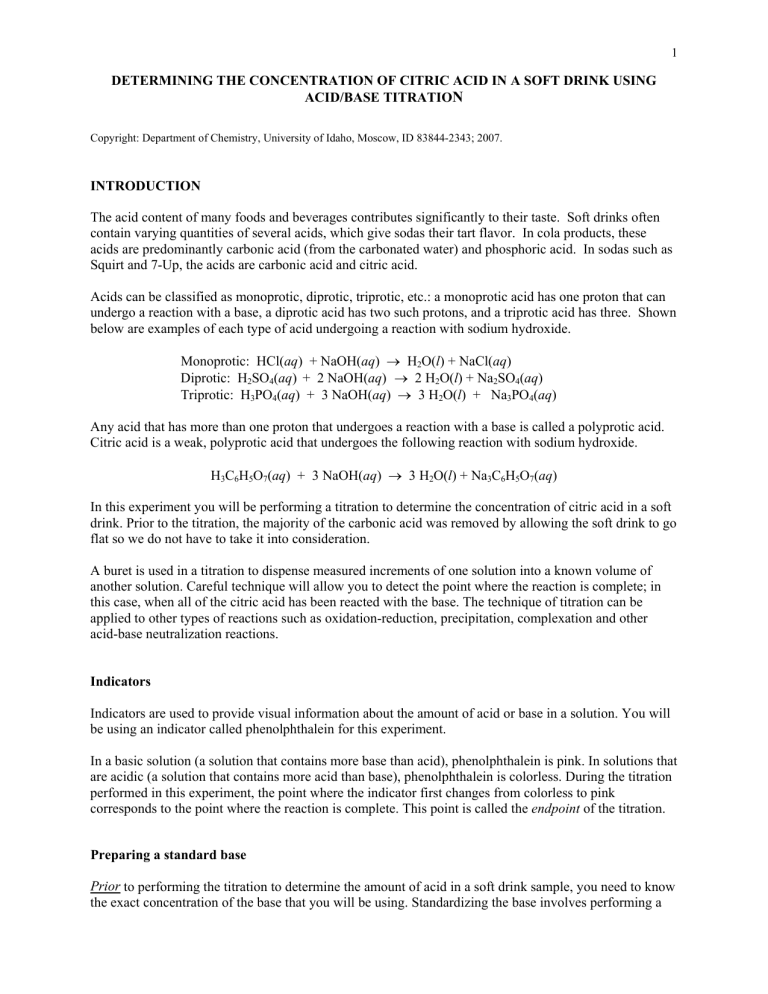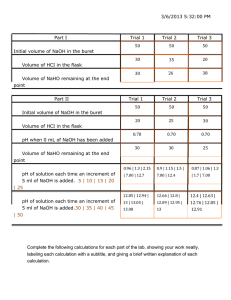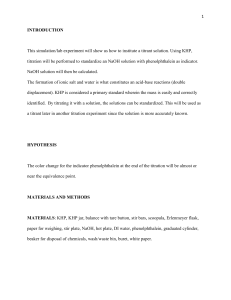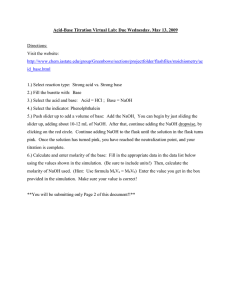
1 DETERMINING THE CONCENTRATION OF CITRIC ACID IN A SOFT DRINK USING ACID/BASE TITRATION Copyright: Department of Chemistry, University of Idaho, Moscow, ID 83844-2343; 2007. INTRODUCTION The acid content of many foods and beverages contributes significantly to their taste. Soft drinks often contain varying quantities of several acids, which give sodas their tart flavor. In cola products, these acids are predominantly carbonic acid (from the carbonated water) and phosphoric acid. In sodas such as Squirt and 7-Up, the acids are carbonic acid and citric acid. Acids can be classified as monoprotic, diprotic, triprotic, etc.: a monoprotic acid has one proton that can undergo a reaction with a base, a diprotic acid has two such protons, and a triprotic acid has three. Shown below are examples of each type of acid undergoing a reaction with sodium hydroxide. Monoprotic: HCl(aq) + NaOH(aq) → H2O(l) + NaCl(aq) Diprotic: H2SO4(aq) + 2 NaOH(aq) → 2 H2O(l) + Na2SO4(aq) Triprotic: H3PO4(aq) + 3 NaOH(aq) → 3 H2O(l) + Na3PO4(aq) Any acid that has more than one proton that undergoes a reaction with a base is called a polyprotic acid. Citric acid is a weak, polyprotic acid that undergoes the following reaction with sodium hydroxide. H3C6H5O7(aq) + 3 NaOH(aq) → 3 H2O(l) + Na3C6H5O7(aq) In this experiment you will be performing a titration to determine the concentration of citric acid in a soft drink. Prior to the titration, the majority of the carbonic acid was removed by allowing the soft drink to go flat so we do not have to take it into consideration. A buret is used in a titration to dispense measured increments of one solution into a known volume of another solution. Careful technique will allow you to detect the point where the reaction is complete; in this case, when all of the citric acid has been reacted with the base. The technique of titration can be applied to other types of reactions such as oxidation-reduction, precipitation, complexation and other acid-base neutralization reactions. Indicators Indicators are used to provide visual information about the amount of acid or base in a solution. You will be using an indicator called phenolphthalein for this experiment. In a basic solution (a solution that contains more base than acid), phenolphthalein is pink. In solutions that are acidic (a solution that contains more acid than base), phenolphthalein is colorless. During the titration performed in this experiment, the point where the indicator first changes from colorless to pink corresponds to the point where the reaction is complete. This point is called the endpoint of the titration. Preparing a standard base Prior to performing the titration to determine the amount of acid in a soft drink sample, you need to know the exact concentration of the base that you will be using. Standardizing the base involves performing a 2 titration with a known amount of a stable acid, which in this case is the monoprotic acid potassium hydrogen phthalate (abbreviated KHP). The reaction of KHP and NaOH is NaOH(aq) + KHC8H4O4(aq) → H2O(l) + KNaC8H4O4(aq) Note that one mole of NaOH reacts with one mole of KHP. Also note that the name of KHP is potassium hydrogen phthalate, not potassium hydrogen phosphorus! PROCEDURE STANDARDIZATION OF NAOH Clean your buret and rinse it with deionized water. Next, rinse your buret twice with 10 mL of the NaOH solution that you will be standardizing. Finally, fill the buret with the NaOH solution. Accurately weigh, to the nearest thousandth of a gram, approximately 0.05 g KHP and transfer it to one of your 250 mL Erlenmeyer flasks. Add approximately 25 mL of deionized water and 2 to 3 drops of the phenolphthalein indicator. Swirl the flask until all the KHP has dissolved. Read the initial volume of NaOH solution in your buret to the nearest hundredth of a mL. Slowly add the NaOH solution to the dissolved KHP until the first faint lasting pink color appears. Placing a white piece of paper under your Erlenmeyer flask helps you to better see this color change. Once a lasting pink color has been reached, read your final volume from your buret. Calculate the molarity of the NaOH solution. Repeat this procedure two more times and calculate the average molarity of the NaOH solution. TITRATION OF A SOFT DRINK The citric acid content in many soft drinks is quite low, so good technique is critical. Obtain 50 mL of your soft drink sample as assigned by your TA. The soft drink samples in your lab have been opened several days in advance to assure it is decarbonated. Pipette 10 mL of the soft drink into a clean 250 mL Erlenmeyer and add 2 to 3 drops of phenolphthalein. Fill your buret with the standardized NaOH. Read the initial volume of NaOH solution in your buret to the nearest hundredth of a mL. Slowly add the NaOH solution to the soft drink until the first faint lasting pink color appears. Once a lasting pink color has been reached, read your final volume from your buret. Calculate the molarity of the citric acid in the soft drink. Repeat this procedure two more times and calculate the average molarity. From your average molarity of citric acid, calculate the number of moles of citric acid per can or bottle of soft drink. Finally, calculate the number of grams of citric acid there are in one can or bottle of soft drink. 3 DATA AND ANALYSIS SHEET: DETERMINING THE CONCENTRATION OF CITRIC ACID IN A SOFT DRINK USING ACID/BASE TITRATION Name: ______________________________________ Date ______________ Lab Partner _________________________________ Assigned soft drink: ________________________________________ Standardization of NaOH Trial 1 Trial 2 Trial 3 Mass of KHP Final buret reading, NaOH Initial buret reading, NaOH Total volume, NaOH Molarity of NaOH Average molarity of NaOH Titration of a soft drink Trial 1 Volume of soft drink Final buret reading, NaOH Initial buret reading, NaOH Total volume, NaOH Molarity of citric acid Average molarity of citric acid Average moles citric acid per can/bottle Average grams citric acid per can/bottle Trial 2 Trial 3 4 Name: ________________________________________ CALCULATIONS PAGE In order to receive credit for your answers on the proceeding page, you must show all work for those answers that require calculations.





